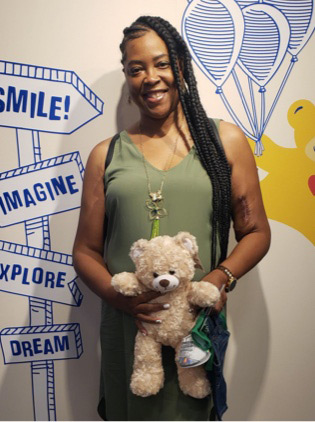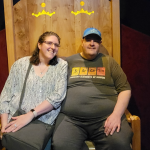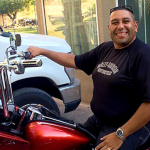Battles and Butterflies
A Kidney Patient's Transformation Story
 It’s strange to think an insect that typically lives just 30 days could be a symbol of life and hope. Few people understand this irony better than kidney patient Tangela, who sees beauty, tragedy, inspiration, and transformation in her favorite creature – the butterfly.
It’s strange to think an insect that typically lives just 30 days could be a symbol of life and hope. Few people understand this irony better than kidney patient Tangela, who sees beauty, tragedy, inspiration, and transformation in her favorite creature – the butterfly.
On September 21, 2012, Tangela received two new kidneys and an opportunity to regain life as she once knew it. It was a precious gift from a precious giver who would never be revealed. All Tangela knows about her donor is he or she was a child – a life cut too short, but whose legacy lives on.
“I take every day as a gift,” reflects Tangela. “And I try to make sure that whatever I do, I’m honoring my donor and the family. I’m living for a child that never really got a chance to live. I’m trying to leave a mark for my donor.”
Leaving her mark is something Tangela has always done well, regardless of circumstances. After graduating from the University of Georgia with a degree in finance, she went on to work for several well-known corporations – all while raising an infant daughter.
While pregnant with her second child, Tangela developed pre-eclampsia, a rare prenatal condition that causes dangerously high blood pressure and other complications. After months of bed rest, she brought home a healthy baby girl. Unfortunately, she also took home a prescription for blood pressure medication, two damaged kidneys, and the knowledge that she would have more health problems down the road. Two years later her nephrologist delivered the news. Tangela had to start dialysis – immediately.
“The next thing I remember is being wheeled into an ER room and coming out with a catheter in my chest and my arm being wrapped up due to a fistula being placed in it,” she recalls. “January 20, 2000, was my first dialysis treatment.”
For the next seven years, Tangela did in-center dialysis and everything else she could to keep her life in order. Her attitude was “My kidneys are sick, everything else still works!” Unable to meet the demands of a job in finance, she went back to school and earned a computer science degree. To stay active, she coached her girls’ sports teams (basketball, cheer, track, swimming, you name it) and chaperoned as many field trips as possible. She also became a substitute teacher at her daughters’ school.
At the clinic she made four close friends, and together they would talk, dialyze, socialize, and support one another. To staff, they were minor celebrities. “We became the ‘Fab 5’ of the clinic,” Tangela recounts. “They loved us.”
Despite her best efforts to remain positive, Tangela battled depression and had a health episode at the clinic that left her with severe anxiety. She struggled to find a treatment schedule that worked for her and her family, and grew weary losing precious moments and family time to dialysis and driving. Seeing her challenges, the clinic manager offered Tangela an opportunity to learn about more frequent home hemodialysis (HHD) with the NxStage System One. She could be the first patient at her clinic to try it.
“She gave me all the good points,” says Tangela. “That I’d likely be able to travel more, be able to dialyze when I wanted to, morning or evening.” The downside? She would have to self-cannulate. At first, Tangela was reluctant (in her own words, “No way!”), but eventually decided to try it.
“After the first week, I got off the machine and felt this burst of energy I hadn’t felt since my pre-dialysis days,” Tangela recalled. “I felt awesome!”
In her second week of training, Tangela learned to self-cannulate and says she laughed out loud when the needle went in. “I thought, ‘This is what you were so scared of?’ At that moment I knew I had my life back.”
With more frequent HHD, Tangela experienced a major shift. Her doctor said she could go off blood pressure pills and reduce her binders to one. She felt less anxiety. She took a new job with a tutoring company. When coaching, she could physically show teams what to do instead of just tell them. A self-regulated dialysis schedule meant an easier time balancing work, family and social calendars. And with newfound energy and a cycler that could make the journey, Tangela began traveling more.
Five more years passed and, as good as she felt, Tangela was facing the reality of a dozen years as a dialysis patient. She was getting burned out and remembers thinking and praying “God I’m tired and I need a miracle.”
In June 2012, there was hopeful news. University of Alabama Medical Center called. They had a kidney. But after rounds of testing, it turned out not to be a match. “I got home and I was just mad at the world,” says Tangela. “I said, ‘I can’t believe this. I got my hopes up and it didn’t happen.”’
A few months later, Tangela and her girls were coming home from cheerleading practice when UAB called again. “I wasn’t even going to go,” remembers Tangela. “I thought ‘I don’t want to be disappointed again. Let someone else have it.’” But her daughter wasn’t about to let mom off the hook. She said “Oh no, you’re going. You’re next in line for a miracle, and you’re going.”
She went.
After more tests and some college sports trash-talking with the nurses, Tangela was braced for bad news, but it never came. The next words she heard were “We have found the perfect kidneys for you and we’ll start surgery in 45 minutes.”
Shocked at the news that she’d be getting not one, but two new kidneys, Tangela and her mom celebrated and cried. But she says she “immediately went from joy to empathy and felt sorrow for the family (of her donor).” As she was rolled into the OR, Tangela made peace with the idea that she was receiving a gift and began “thanking God and praying for the family.”
Seven years later, Tangela remains a healthy transplant patient and, as a NxStage Patient Advocate, is “leaving her mark” by helping others learn about treatment options and self-advocacy.
Regarding transplantation, Tangela explored getting listed in multiple states and clinics and she encourages candidates to do the research and find out their options. “Every clinic has different requirements”.
“My goal is to let people know that you can make it through it,” says Tangela. “Sometimes we have detours we are not expecting but, just like on the highway, you have to navigate to get to your destination, even if you don’t know what that destination will be.”
 Tangela continues to honor her gift and its giver in her thoughts and actions. At every speaking engagement, she wears something with a butterfly on it. And every year on her “second birthday” (September 21, the date of her transplant) she does something in remembrance of the child donor, to whom she gave the name Jordan. This past year she went to Build-A-Bear and created a plush little critter named Jordan Birmingham (Birmingham, AL being the location of her surgery).
Tangela continues to honor her gift and its giver in her thoughts and actions. At every speaking engagement, she wears something with a butterfly on it. And every year on her “second birthday” (September 21, the date of her transplant) she does something in remembrance of the child donor, to whom she gave the name Jordan. This past year she went to Build-A-Bear and created a plush little critter named Jordan Birmingham (Birmingham, AL being the location of her surgery).
“I chose the name Jordan because it’s a boy’s and girl’s name,” she says. “But also, because I feel like I’ve crossed the Jordan River into the promised land on this journey.”
April is National Donate Life Month. To learn more about organ donation, visit www.donatelife.net/ndlm
The reported benefits of home hemodialysis (HHD) may not be experienced by all patients.
The NxStage System is a prescription device and, like all medical devices, involves some risks. The risks associated with hemodialysis treatments in any environment include, but are not limited to, high blood pressure, fluid overload, low blood pressure, heart-related issues, and vascular access complications. When vascular access is exposed to more frequent use, infection of the site, and other access related complications may also be potential risks. The medical devices used in hemodialysis therapies may add additional risks including air entering the bloodstream, and blood loss due to clotting or accidental disconnection of the blood tubing set.
Home hemodialysis with the NxStage System during waking hours may not require a care partner, provided a physician and a qualified patient agree that solo home hemodialysis is appropriate. Patients performing nocturnal treatments are required to have a care partner. Care partners are trained on proper operation and how to get medical or technical help if needed.
Certain risks associated with hemodialysis treatment are increased when performing solo HHD because no one is present to help the patient respond to health emergencies. If patients experience needles coming out, blood loss, or very low blood pressure during solo HHD, they may lose consciousness or become physically unable to correct the health emergency. Losing consciousness or otherwise becoming impaired during any health emergency while alone could result in significant injury or death. Additional ancillary devices and training are required when performing solo HHD
Certain risks associated with hemodialysis treatment are increased when performing nocturnal therapy due to the length of treatment time and because therapy is performed while the patient and care partner are sleeping. These risks include, but are not limited to, blood access disconnects and blood loss during sleep, blood clotting due to slower blood flow and/or increased treatment time, and delayed response to alarms when waking from sleep.
Patients should consult their doctor to understand the risks and responsibilities of performing these therapies using the NxStage System.





